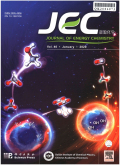- 钛学术文献服务平台 \
- 学术期刊 \
- 工业技术期刊 \
- 石油与天然气工业期刊 \
- 能源化学期刊 \
Carbon-coated cubic-phase molybdenum carbide nanoparticle for enhanced photocatalytic H2-evolution performance of TiO2
Carbon-coated cubic-phase molybdenum carbide nanoparticle for enhanced photocatalytic H2-evolution performance of TiO2
基本信息来源于合作网站,原文需代理用户跳转至来源网站获取
摘要:
Conventional hexagonal dimolybdenum carbide(Mo2C)as a good cocatalyst has been widely applied for the enhanced photocatalytic hydrogen production of various photocatalysts.Compared with the hexag-onal Mo2C,however,the investigation about cubic molybdenum carbide(MoC)is still very limited in photocatalytic field.In this study,carbon-coated cubic molybdenum carbide(MoC@C)nanoparticle was synthesized and used as an effective cocatalyst to improve the H2-evolution efficiency of TiO2.The cubic MoC@C can be obtained by adjusting the mass ratio of C3N3(NH2)3 to(NH4)6Mo7O24(2∶1)and controlling the calcination temperature to 800 ℃.When the above cubic MoC@C nanoparticles were evenly loaded on the TiO2 via a sonication-assisted deposition,a homogeneous composite of TiO2/MoC@C was formed due to the strong coupling interface between TiO2 and cubic MoC nanoparticles.More importantly,the highest H2-production rate of TiO2/MoC@C reached 504 μmol h-1 g-1(AQE=1.43%),which was 50 times as high as that of the pure TiO2.The enhanced performance of TiO2/MoC@C can be attributed to the synergistic effect of carbon layer as an electron mediator and the cubic MoC as interfacial H2-evolution active sites.This work provides a feasible guideline to develop high-efficiency Mo-based cocatalysts for potential applications in the H2-evolution field.

推荐文章
TiO2光催化脱H2S的应用
纳米TiP2
脱H2S率
光催化
不同物相TiO2对H2O2/O3氧化效能的影响
臭氧
双氧水
氧化
催化剂
二氧化钛
物相
自由基
PI/TiO2纳米复合膜的H2/CH4和H2/N2分离性能
聚酰亚胺
二氧化钛
纳米复合材料
溶胶-凝胶
氢分离
回收
复合膜
分离性能
TiO2形貌调控研究
形貌
TiO2
合成
内容分析
关键词云
关键词热度
相关文献总数
(/次)
(/年)
引文网络
引文网络
二级参考文献 (0)
共引文献 (0)
参考文献 (1)
节点文献
引证文献 (0)
同被引文献 (0)
二级引证文献 (0)
2000(1)
- 参考文献(1)
- 二级参考文献(0)
2020(0)
- 参考文献(0)
- 二级参考文献(0)
- 引证文献(0)
- 二级引证文献(0)
引文网络交叉学科
相关学者/机构
期刊影响力
能源化学
主办单位:
中国科学院大连化学物理研究所
中国科学院成都有机化学研究所
出版周期:
双月刊
ISSN:
2095-4956
CN:
10-1287/O6
开本:
出版地:
大连市中山路457号
邮发代号:
创刊时间:
语种:
eng
出版文献量(篇)
2804
总下载数(次)
0
总被引数(次)
7996
期刊文献
相关文献
推荐文献
- 期刊分类
- 期刊(年)
- 期刊(期)
- 期刊推荐
一般工业技术
交通运输
军事科技
冶金工业
动力工程
化学工业
原子能技术
大学学报
建筑科学
无线电电子学与电信技术
机械与仪表工业
水利工程
环境科学与安全科学
电工技术
石油与天然气工业
矿业工程
自动化技术与计算机技术
航空航天
轻工业与手工业
金属学与金属工艺
能源化学2022
能源化学2021
能源化学2020
能源化学2019
能源化学2018
能源化学2017
能源化学2016
能源化学2015
能源化学2014
能源化学2013
能源化学2012
能源化学2011
能源化学2010
能源化学2009
能源化学2008
能源化学2007
能源化学2006
能源化学2005
能源化学2004
能源化学2003
能源化学2002
能源化学2001
能源化学2020年第9期
能源化学2020年第8期
能源化学2020年第7期
能源化学2020年第6期
能源化学2020年第5期
能源化学2020年第4期
能源化学2020年第3期
能源化学2020年第12期
能源化学2020年第11期
能源化学2020年第10期
能源化学2020年第1期

 免费查重
免费查重










